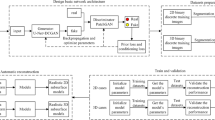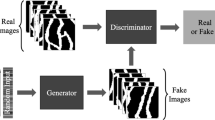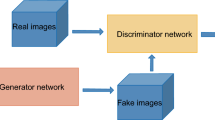Abstract
How to reconstruct a credible three-dimensional (3D) geological model from very limited survey data, e.g. boreholes, outcrop, and two-dimensional (2D) images, is challenging in the field of 3D geological modeling. Against the limitations of the huge computational consumption and complex parameterization of geostatistics-based stochastic simulation methods, we propose an automatic reconstruction method of 3D geological models based on deep convolutional generative adversarial network (DCGAN). In this work, 2D geological sections are used as conditioning data to generate 3D geological models automatically. Various realizations can be reproduced under a same DCGAN model established through deep network training. A U-Net structure is used to enhance the fitting effect of the DCGAN model. In addition, joint loss functions are exploited to increase the similarity between 3D realizations and reference models. Three synthetic datasets were used to verify the capability of the method presented in this paper. Experimental results show that the proposed 3D automatic reconstruction method based on DCGAN can capture the features, trends and spatial patterns of geological structures well. The output models obey the used conditioning data. The complex heterogeneous structures are reconstructed more accurately and quickly by using the proposed method.
Similar content being viewed by others
Data availability
The test data used in this work were collected from open datasets, with appropriate citations given in this paper. They are available on request from the corresponding author (chenqiyu403@163.com).
References
Arjovsky, M., Chintala, S., Bottou, L.: Wasserstein generative adversarial networks. In: International conference on machine learning. PMLR, pp. 214–223 (2017)
Arpat, G.B., Caers, J.: Conditional simulation with patterns. Math. Geol. 39(2), 177–203 (2007)
Bai, T., Tahmasebi, P.: Hybrid geological modeling: combining machine learning and multiple-point statistics. Comput. Geosci. 142, 104519 (2020)
Bynagari, N.B.: GANs trained by a two time-scale update rule converge to a local Nash equilibrium. Asian Journal of Applied Science and Engineering. 8, 25–34 (2019)
Chan, S., Elsheikh, A.H.: Parametrization of stochastic inputs using generative adversarial 21 networks with application in geology. Front. Water. 2, 5 (2020)
Chen, L.C., Papandreou, G., Kokkinos, I., Murphy, K., Yuille, A.L.: Deeplab: semantic image segmentation with deep convolutional nets, atrous convolution, and fully connected crfs. IEEE Trans. Pattern Anal. Mach. Intell. 40(4), 834–848 (2017)
Chen, Q., Liu, G., Ma, X., Li, X., He, Z.: 3D stochastic modeling framework for quaternary sediments using multiple-point statistics: a case study in Minjiang estuary area, Southeast China. Comput. Geosci. 136, 104404 (2020)
Chen, Q., Liu, G., Ma, X., Zhang, J., Zhang, X.: Conditional multiple-point geostatistical simulation for unevenly distributed sample data. Stoch. Env. Res. Risk A. 33(4), 973–987 (2019)
Chen, Q., Mariethoz, G., Liu, G., Comunian, A., Ma, X.: Locality-based 3-D multiple-point statistics reconstruction using 2-D geological cross sections. Hydrol. Earth Syst. Sci. 22(12), 6547–6566 (2018)
Chen, T., Cheng, M.M., Tan, P., Shamir, A., Hu, S.M.: Sketch2photo: internet image montage. ACM Trans. Graph. 28(5), 1–10 (2009)
Chen, X., Wan, D.: GPU accelerated MPS method for large-scale 3-D violent free surface flows. Ocean Eng. 171, 677–694 (2019)
Cui, Z., Chen, Q., Liu, G., Ma, X., Que, X.: Multiple-point geostatistical simulation based on conditional conduction probability. Stoch. Env. Res. Risk A. 35, 1355–1368 (2021a)
Cui, Z., Chen, Q., Liu, G., Mariethoz, G., Ma, X.: Hybrid parallel framework for multiple-point geostatistics on Tianhe-2: a robust solution for large-scale simulation. Comput. Geosci. 157, 104923 (2021b)
Demir, U., Unal, G.: Patch-based image inpainting with generative adversarial networks. arXiv preprint arXiv:1803.07422 (2018)
Deutsch, C.V., Tran, T.T.: FLUVSIM: a program for object-based stochastic modeling of fluvial depositional systems. Comput. Geosci. 28(4), 525–535 (2002)
Dramsch, J.S.: 70 years of machine learning in geoscience in review. Adv. Geophys. 61, 1–55 (2020)
Dubey, A.K., Jain, V.: Comparative study of convolution neural network’s relu and leaky-relu activation functions. In:Applications of Computing, Automation and Wireless Systems in Electrical Engineering. Springer, Singapore, pp. 873–880 (2019)
Dupont, E., Zhang, T., Tilke, P., Liang, L., Bailey, W.: Generating realistic geology conditioned on physical measurements with generative adversarial networks. arXiv preprint arXiv:1802.03065 (2018)
Fang, W., Zhang, F., Sheng, V.S., Ding, Y.: A method for improving CNN-based image recognition using DCGAN. Computers, Materials and Continua. 57(1), 167–178 (2018)
Feng, J., He, X., Teng, Q., Ren, C., Chen, H., Li, Y.: Reconstruction of porous media from extremely limited information using conditional generative adversarial networks. Phys. Rev. E. 100(3), 033308 (2019)
Feng, J., Teng, Q., Li, B., He, X., Chen, H., Li, Y.: An end-to-end three-dimensional reconstruction framework of porous media from a single two-dimensional image based on deep learning. Comput. Methods Appl. Mech. Eng. 368, 113043 (2020)
Gan, Z., Henao, R., Carlson, D., Carin, L.: Learning deep sigmoid belief networks with data augmentation. In: Artificial Intelligence and Statistics. PMLR, pp. 268–276 (2015)
Gao, M., He, X., Teng, Q., Zuo, C., Chen, D.: Reconstruction of three-dimensional porous media from a single two-dimensional image using three-step sampling. Phys. Rev. E. 91(1), 013308 (2015)
Gatys, L., Ecker, A.S., Bethge, M.: Texture synthesis using convolutional neural networks. Adv. Neural Inf. Proces. Syst. 28, 262–270 (2015)
Goodfellow, I., Pouget-Abadie, J., Mirza, M., Xu, B., Warde-Farley, D., Ozair, S., Courville, A., Bengio, Y.: Generative adversarial nets. In: Advances in neural information processing systems. pp. 2672–2680 (2014)
Goodfellow, I., Bengio, Y., Courville, A.: Deep learning. MIT Press. (2016)
Guardiano, F.B., Srivastava, R.M.: Multivariate geostatistics: beyond bivariate moments. In: Geostatistics Troia’92. Springer, Dordrecht, pp. 133–144 (1993)
Guo, J., Li, Y., Jessell, M., Giraud, J., Li, C., Wu, L., Li, F., Liu, S.: 3D geological structure inversion from Noddy-generated magnetic data using deep learning methods. Comput. Geosci. 149, 104701 (2021)
Hermans, T., Nguyen, F., Caers, J.: Uncertainty in training image-based inversion of hydraulic head data constrained to ERT data: workflow and case study. Water Resour. Res. 51(7), 5332–5352 (2015)
Hori, C., Gotoh, H., Ikari, H., Khayyer, A.: GPU-acceleration for moving particle semi-implicit method. Comput. Fluids. 51(1), 174–183 (2011)
Ioffe, S., Szegedy, C.: Batch normalization: Accelerating deep network training by reducing internal covariate shift. In: International conference on machine learning. PMLR, pp. 448–456 (2015)
Isola, P., Zhu, J.Y., Zhou, T., Efros, A.A.: Image-to-image translation with conditional adversarial networks. In: Proceedings of the IEEE conference on computer vision and pattern recognition. pp. 1125–1134 (2017)
Jessell, M., Pakyuz-Charrier, E., Lindsay, M., Giraud, J., de Kemp, E., Arribas, A.M., Mauk, J.L.: Assessing and mitigating uncertainty in three-dimensional geologic models in contrasting geologic scenarios. Metals, Minerals, and Society. 21, 63–74 (2018)
Jessell, M., Guo, J., Li, Y., Lindsay, M., Scalzo, R., Giraud, J., Pirot, G., Cripps, E., Ogarko, V.: Into the Noddyverse: a massive data store of 3D geological models for machine learning and inversion applications. Earth System Science Data. 14(1), 381–392 (2022)
Karpatne, A., Ebert-Uphoff, I., Ravela, S., Babaie, H.A., Kumar, V.: Machine learning for the geosciences: challenges and opportunities. IEEE Trans. Knowl. Data Eng. 31(8), 1544–1554 (2018)
Kingma, D.P., Welling, M.: An introduction to variational autoencoders. Foundations and Trends® in Machine Learning, 12(4), 307–392 (2019)
Laloy, E., Hérault, R., Lee, J., Jacques, D., Linde, N.: Inversion using a new low-dimensional representation of complex binary geological media based on a deep neural network. Adv. Water Resour. 110, 387–405 (2017)
Li, L., Srinivasan, S., Zhou, H., Gomez-Hernandez, J.J.: Two-point or multiple-point statistics? A comparison between the ensemble Kalman filtering and the ensemble pattern matching inverse methods. Adv. Water Resour. 86, 297–310 (2015)
Linde, N., Renard, P., Mukerji, T., Caers, J.: Geological realism in hydrogeological and geophysical inverse modeling: a review. Adv. Water Resour. 86, 86–101 (2015)
Liu, Q., Liu, W., Yao, J., Liu, Y., Pan, M.: An improved method of reservoir facies modeling based on generative adversarial networks. Energies. 14(13), 3873 (2021)
Mariethoz, G., Caers, J.: Multiple-point geostatistics: stochastic modeling with training images. John Wiley & Sons. (2014)
Mariethoz, G., Renard, P., Straubhaar, J.: The direct sampling method to perform multiple-point geostatistical simulations. Water Resour. Res. 46(11), W11536 (2010)
Miyato, T., Kataoka, T., Koyama, M., Yoshida, Y.: Spectral normalization for generative adversarial networks. arXiv preprint arXiv:1802.05957 (2018)
Mosser, L., Dubrule, O., Blunt, M.J.: Reconstruction of three-dimensional porous media using generative adversarial neural networks. Phys. Rev. 96(4), 043309 (2017)
Nicolas, A., Mello, A.W., Sun, Y., Johnson, D.R., Sangid, M.D.: Reconstruction methods and analysis of subsurface uncertainty for anisotropic microstructures. Mater. Sci. Eng. A. 760, 76–87 (2019)
Nussbaumer, R., Mariethoz, G., Gloaguen, E., Holloger, K.: Which path to choose in sequential Gaussian simulation. Math. Geosci. 50(1), 97–12 (2018)
Oliver, M.A., Webster, R.: Kriging: a method of interpolation for geographical information systems. International Journal of Geographical Information System. 4(3), 313–332 (1990)
Oord, A., Kalchbrenner, N., Vinyals, O., Espeholt, L., Graves, A., Kavukcuoglu, K.: Conditional image generation with pixelCNN decoders. In: Proceedings of the 30th International Conference on Neural Information Processing Systems, pp. 4797–4805 (2016)
Pyrcz, M.J., Deutsch, C.V.: Geoestatistical Reservoir Modeling. Oxford University Press, Oxford (2014)
Rao, D.Y., Wu, X.J., Li, H., Kittler, J., Xu, T.Y.: UMFA: a photorealistic style transfer method based on U-net and multi-layer feature aggregation. Journal of Electronic Imaging. 30(5), 053013 (2021)
Renard, P., Mariethoz, G.: Special issue on 20 years of multiple-point statistics: part 1. Math. Geosci. 46(2), 129–131 (2014)
Ronneberger, O., Fischer, P., Brox, T.: U-net: Convolutional networks for biomedical image segmentation. In: International Conference on Medical image computing and computer-assisted intervention. Springer, pp. 234–241 (2015)
Song, S., Mukerji, T., Hou, J.: Geological facies modeling based on progressive growing of generative adversarial networks (GANs). Comput. Geosci. 25(3), 1251–1273 (2021)
Strebelle, S.: Conditional simulation of complex geological structures using multiple-point statistics. Math. Geol. 34(1), 1–21 (2002)
Tahmasebi, P., Hezarkhani, A., Sahimi, M.: Multiple-point geostatistical modeling based on the cross-correlation functions. Comput. Geosci. 16(3), 779–797 (2012)
Tahmasebi, P., Sahimi, M., Caers, J.: MS-CCSIM: accelerating pattern-based geostatistical simulation of categorical variables using a multi-scale search in Fourier space. Comput. Geosci. 67, 75–88 (2014)
Tahmasebi, P., Kamrava, S., Bai, T., Sahimi, M.: Machine learning in geo-and environmental sciences: from small to large scale. Adv. Water Resour. 142, 103619 (2020)
Van der Baan, M., Jutten, C.: Neural networks in geophysical applications. Geophysics. 65(4), 1032–1047 (2000)
Wellmann, F., Caumon, G.: 3-D structural geological models: concepts, methods, and uncertainties. Advances in Geophysics. Elsevier. 59, 1–121 (2018)
Yang, L., Hou, W., Cui, C., Cui, J.: GOSIM: a multi-scale iterative multiple-point statistics algorithm with global optimization. Comput. Geosci. 89, 57–70 (2016)
Zhang, T., Ji, X., Zhang, A.: Reconstruction of fluvial reservoirs using multiple-stage concurrent generative adversarial networks. Comput. Geosci. 25, 1983–2004 (2021). https://doi.org/10.1007/s10596-021-10086-7
Zheng, S., Song, Y., Leung, T., Goodfellow, I.: Improving the robustness of deep neural networks via stability training. In: Proceedings of the IEEE conference on computer vision and pattern recognition, pp. 4480–4488 (2016)
Zuo, R., Xiong, Y., Wang, J., Carranza, E.J.M.: Deep learning and its application in 7 geochemical mapping. Earth Sci. Rev. 192, 1–14 (2019)
Acknowledgements
This work is supported by the National Natural Science Foundation of China (41902304, 42172333, U1711267).
Code availability
The source code developed by using Python is made open and accessible on GitHub: https://github.com/GS-3DMG/DCGAN-Reconstruction.
Author information
Authors and Affiliations
Corresponding author
Ethics declarations
Conflict of interest
The authors declare that they have no conflict of interest.
Additional information
Publisher’s note
Springer Nature remains neutral with regard to jurisdictional claims in published maps and institutional affiliations.
Rights and permissions
About this article
Cite this article
Yang, Z., Chen, Q., Cui, Z. et al. Automatic reconstruction method of 3D geological models based on deep convolutional generative adversarial networks. Comput Geosci 26, 1135–1150 (2022). https://doi.org/10.1007/s10596-022-10152-8
Received:
Accepted:
Published:
Issue Date:
DOI: https://doi.org/10.1007/s10596-022-10152-8




